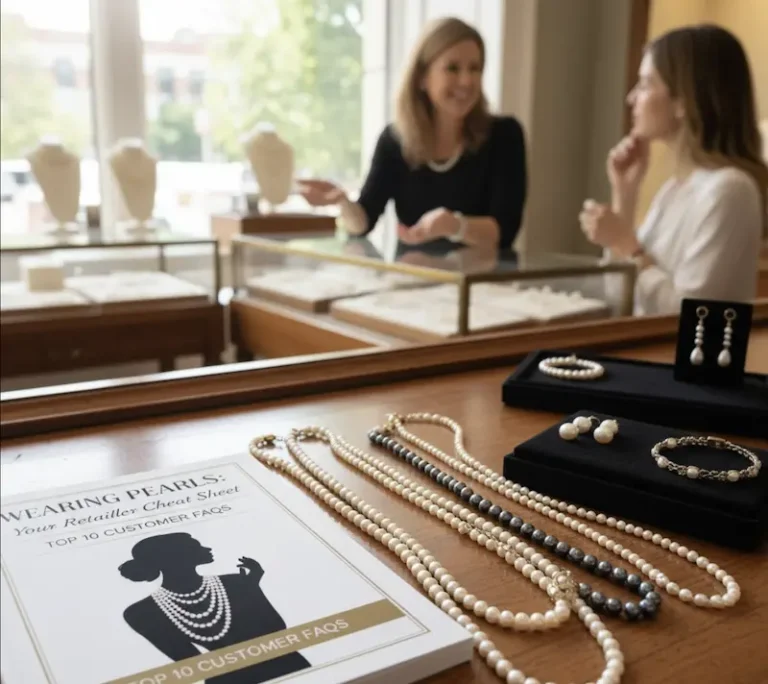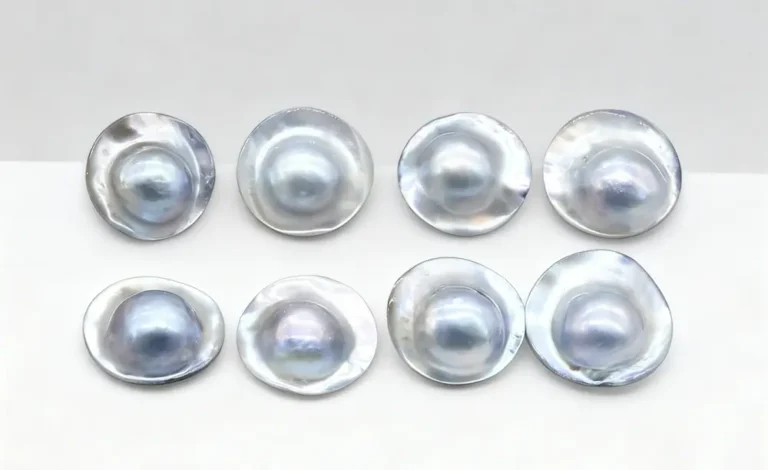For thousands of years, people have been drawn to freshwater pearls because of their lovely luster and symbolic significance.Unlike diamonds and sapphires that form deep within the earth, these organic gems come from the tranquil waters of rivers, lakes, and ponds. Each pearl beautifully showcases nature’s patience and creativity. Throughout history, freshwater pearls have adorned powerful figures, from Chinese emperors to Renaissance nobles.They’ve always represented something more than mere adornment.
Jewelry designers and collectors worldwide still cherish these beautiful gems. Their story stretches back thousands of years, woven into many cultures. Knowing this rich history might help you understand why freshwater pearls remain so popular in jewelry today.
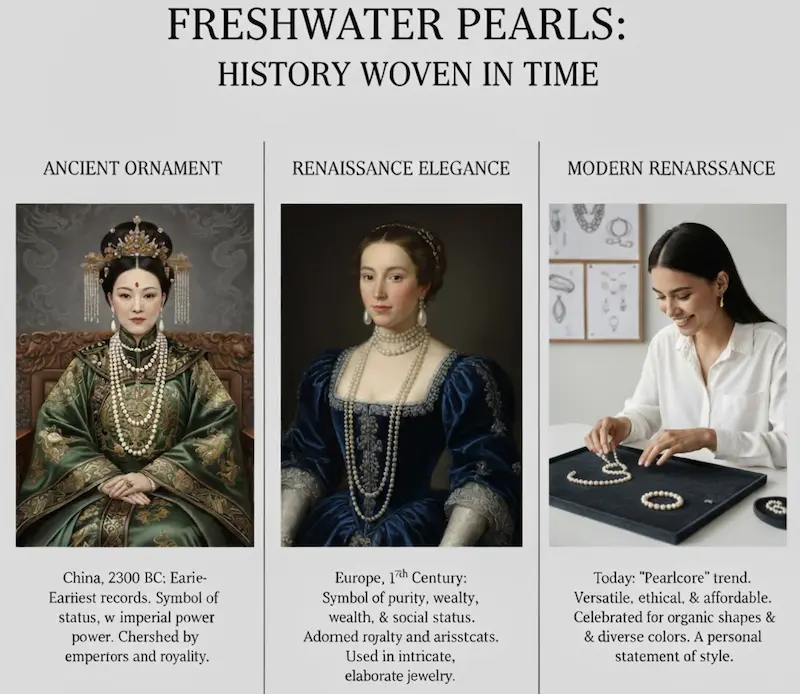
Ancient Origins: Where Freshwater Pearls First Captivated Humanity
Freshwater pearls have been around for a long time, since the beginning of time. Archaeological evidence indicates that ancient civilisations inadvertently discovered these jewels, presumably when foraging for food along riverbanks and lakeshores. What they found changed human culture for good.
Early Chinese Reverence
China stands as one of the earliest documented admirers of freshwater pearls. Historical documents from more than 4,000 years ago talk of pearls that came from China’s rivers and ponds, especially the Huai River. During the Han Dynasty (206 BC–220 AD), Chinese monarchs typically buried pearl jewels with them to show their wealth, status, and the afterlife.
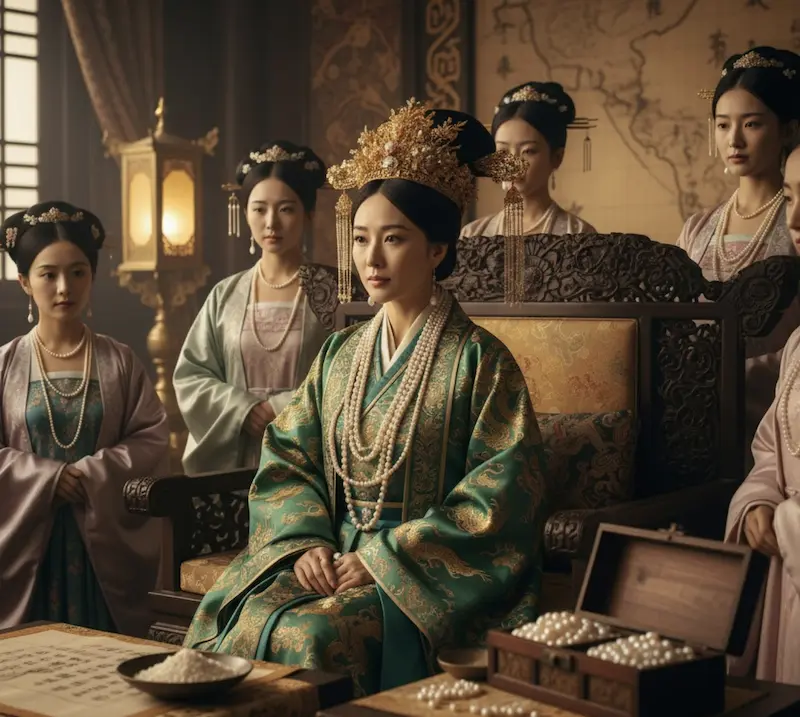
It’s amazing that China didn’t merely acquire these treasures; they also came up with new ideas. Chinese craftsmen made cultured pearls as early as 1082 A.D., long before the method became popular around the world. Some ancient Chinese rulers thought that pearls held the wisdom of dragons. Some even ate crushed pearls in the hopes of gaining their magical knowledge.
Ancient Egypt and the Nile’s Treasures

Going way back, the Ancient Egyptians were using pearl jewelry more than 5,200 years ago, making them some of the earliest fans of pearls we know about. When archaeologists dig things up, they find that pharaohs and nobles wore pearls, often in burial masks and fancy ceremonial outfits. Egyptians saw freshwater pearls as symbols of protection and cleanliness, believing they could keep the dead safe on their journey to the next world.
India’s Spiritual Connection
Some Indian spiritual stories talk about freshwater pearls. One tradition relates that Lord Krishna took the first pearl from the ocean as a wedding present for Pandaia. This pearl represented love, prosperity, and divine favor. Also, an ancient Indian epic called the “Ramayana” mentions a necklace with 27 pearls. These gems symbolized courage and achieving one’s rightful destiny.

For ages, the Red Sea and India’s coast were prime locations for finding pearls, and old texts really emphasized how precious they were. In Vedic mythology, they called pearls the “daughter of the Moon,” saying they were born from the Earth’s waters and brought to life by lightning. That’s a really beautiful way to describe their almost magical beauty.
The Cultural Significance Across Civilizations
Ancient Greece and Rome: Symbols of Love and Power

Ancient Greece wove freshwater pearls into their mythology and daily life. Greeks believed pearls were the tears of Aphrodite, the goddess of love and beauty. Brides wore pearl jewelry to ensure happy, fruitful marriages, establishing a tradition that persists today. The association with femininity and romance made these gems essential to wedding ceremonies.
Rome’s infatuation with pearls reached new heights. Pearls were the most important sign of wealth at the height of the Roman Empire. Laws were created that limited pearl possession to the governing classes, which shows how valuable they were thought to be. Rich Romans used these shiny gems to ornament not just themselves but also their clothes and furniture.
Suetonius, a Roman historian, wrote that General Vitellius paid for an entire military expedition by selling just one of his mother’s pearl earrings. This one story shows how much people valued high-quality pearls at this time. Romans thought that freshwater pearls were pure because they were thought to be tears shed by the gods.
Medieval Europe and Renaissance Nobility
Freshwater pearls symbolised power in the Middle Ages and Renaissance. European nobles wore pearl jewels to symbolise their wealth and purity. Christian art associated jewels with the Virgin Mary, who symbolised spiritual purity.
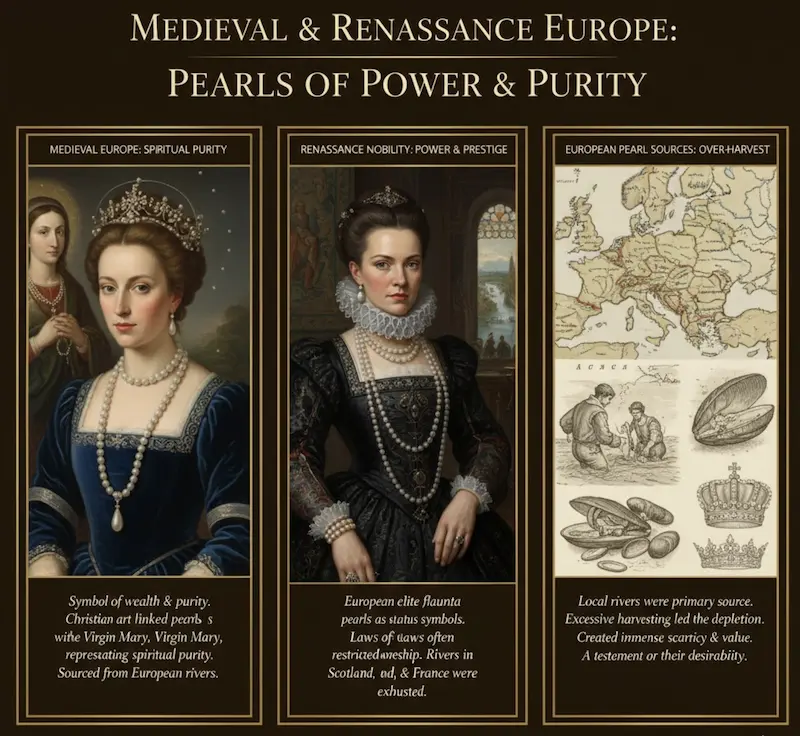
The pearls sold in local markets came from rivers in Scotland, Austria, France, Ireland, and other places in Europe. This shows how much people wanted these natural resources because they finally ran out because they were taken too much.
North American Indigenous Traditions
The first Europeans to come to North America found that the Native Americans had been gathering freshwater pearls for hundreds of years. The Ohio, Mississippi, and Tennessee River valleys made pearls that were so beautiful that people began calling the New World the “Land of Pearls.”
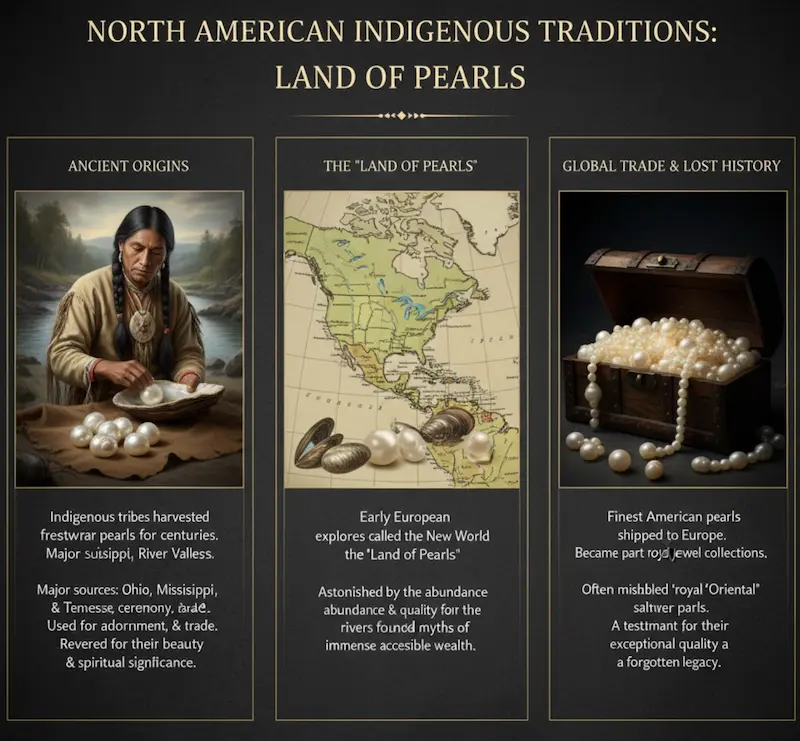
These American freshwater pearls were really big and shiny. The best ones were sent to Europe, where they became part of royal jewel collections. Many of them are still on display today, but they are incorrectly labelled as saltwater pearls from the Orient. This mistake in history shows how high-quality North American freshwater pearls are.
The Symbolism and Meaning Behind Freshwater Pearls
Because they may symbolise so many various things, freshwater pearls are highly prevalent. These diamonds have always stood for fundamental human concepts and ambitions, no matter what civilisation they came from.
Purity and Innocence
White freshwater pearls have long been a symbol of purity and innocence, which makes them great for weddings and other spiritual ceremonies. I think of moonlight and calm when I see their smooth, shining surface. Many cultures, such as the Romans who thought of celestial tears and Christians who painted the Virgin Mary, consider this link to purity.
Wisdom and Patience
Pearls take a long time to grow, usually between three and seven years. This makes them naturally associated with knowledge and patience. In Hindu mythology, pearls are the wisdom that the gods have gathered over time. In Chinese culture, pearls were thought to hold dragon wisdom. In Western cultures, “pearls of great price” refers to the value of wisdom itself.
This meaning is clear to anyone who knows how pearls grow. Layer by tiny layer, nacre grows around an irritant, changing it from something annoying to something beautiful. It’s a good way to think about how problems can help you grow as a person.
Love, Romance, and Fertility
To the Greeks, pearls were linked to Aphrodite, which meant they were related to love. Bridals who wore pearls thought it would help them have children and be happy in their marriages. This practice spread to other countries, and some people thought that eating or wearing pearls could make them more fertile.
The fact that pearls are shiny and come from living things may have made these connections to life, love, and reproduction even stronger.
Protection and Healing
People have always thought that freshwater pearls could protect and heal. The Romans thought that pearls could keep men safe in combat. Traditional Chinese medicine employed crushed pearls to help with a wide range of health conditions, from heart problems to eye problems.
Modern science doesn’t back up these assertions about pearls being good for your health, but many spiritual practices still believe in their protective powers. Many people still wear them to keep bad energy away and improve their health in general.
The Revolutionary Shift: From Wild Pearls to Cultured Production
The Rarity of Natural Pearls
Before the 1900s, all pearls were natural and made by accident in wild molluscs. To find them, people had to go on dangerous dive trips that often turned up nothing. Because pearls are so rare, only the richest elite could afford to wear expensive jewellery with them. A good string of real pearls costs more than most people earn in their whole life.
Because there weren’t enough, people fished too much, and by the 1800s, pearl beds in Central American seas and North American streams were empty. Industrialisation and pollution have made things worse for groups of freshwater molluscs. It looked like the pearl trade was going to fail.
Kokichi Mikimoto’s Innovation
In the late 1800s and early 1900s, Kokichi Mikimoto, the son of a Japanese noodle maker, came up with dependable ways to grow pearls. This changed everything. Mikimoto got a patent in 1916 for growing pearls that were exactly round. To make his discovery, he put a nucleus, which was usually a small piece of shell, into an oyster or mussel. The shell would then cover the nucleus with nacre.
This new idea made it easier for everyone to own a pearl. A lot more people were able to get things that were previously only available to royalty and the very rich. The farmed pearl business changed the whole jewellery business.
China’s Dominance in Freshwater Pearl Production
Japan was the first country to harvest saltwater pearls, but China changed the way freshwater pearls are made. In the 1980s, Chinese farmers started growing tissue-nucleated freshwater pearls. At first, they made little, oddly shaped “rice crispy” pearls. These cheap gems aren’t perfectly round, yet they make pearl jewellery possible for millions of women around the world.
Through the 1990s and 2000s, Chinese pearl farming techniques improved dramatically. Farmers developed “potato pearls” (off-round with solid nacre), then progressively rounder specimens. Today, China produces virtually all commercial freshwater pearls—approximately 1,500 tons annually—using primarily the triangle shell mussel (Hyriopsis cumingii).
One of the main benefits of freshwater mussels over saltwater oysters is that they are more productive. Saltwater oysters usually only make one pearl at a time, but freshwater mussels can make 24 to 32 pearls in one harvest. This is why wholesale pearls from freshwater sources are usually less expensive than those from saltwater sources.
Regional Pearl Traditions and Their Unique Characteristics
| Region | Historical Significance | Primary Sources | Cultural Meaning |
|---|---|---|---|
| China | 4,000+ year history; earliest cultured pearls (1082 AD) | Rivers and ponds (Yangtze River basin) | Wisdom, prosperity, dragon power |
| India | Red Sea and coastal sources; spiritual significance | Coastal waters, rivers | Purity, divine love, Krishna’s blessing |
| Japan | Traditional Ama divers; saltwater focus | Lake Biwa (historical) | Beauty, perfection, moon connection |
| Europe | Renaissance status symbol | Scottish, Austrian, French, Irish rivers | Nobility, purity, Virgin Mary |
| North America | “Land of Pearls”; Indigenous use | Ohio, Mississippi, Tennessee Rivers | Trade value, natural beauty |
This table illustrates how different regions developed unique relationships with freshwater pearls based on local sources and cultural values.
Modern Cultural Significance and the Global Pearl Market
Contemporary Symbolism
Freshwater pearls still have their historical connotation, but they still look good with modern styles. They are still popular for weddings since they signify for new beginnings and purity. People who were born in June have pearls as their birthstone. People usually offer pearls as gifts during their third wedding anniversary.
People like freshwater pearls these days since they can be worn in many ways and last a long time. You may make jewellery that is both classic and modern by using natural colours like white, cream, pink, lavender, peach, and rare metals.
The Role of Pearl Manufacturers in Preserving Quality
As freshwater pearls become more and more popular around the world, it is more crucial than ever to find trustworthy Pearl Manufacturer. Their main goals are quality control, sustainable farming, and ethical sourcing. This will keep these gems attractive and precious while also conserving freshwater environments.
Pearl farms now need to find a way to generate pearls that is also good for the environment. Pollution, climate change, and disease are all threats to the mussel populations. If you want to keep freshwater pearls around for a long time, you need to take care of the delicate places where they grow. They don’t use too much water to do this, and they maintain it clean.
Design Innovation and Market Trends
Modern jewellery designers employ freshwater pearls’ unique features. All pearls were once the same. Market loves rosebud, keshi pearl, and baroque pearls. People who want something real and unique will like these wavy shapes, which look like the way pearls form in nature.
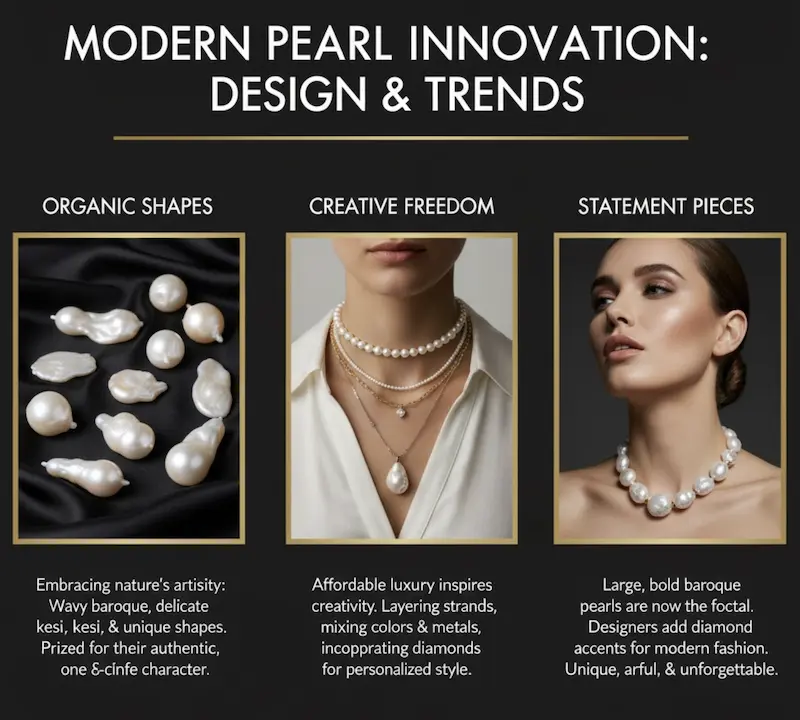
Now that beautiful freshwater pearls are affordable, new ideas have emerged. Designers layer strands, blend pearl hues, add diamonds, or showcase large baroque pearls. Creative freedom was difficult when pearls were too expensive.
Why Freshwater Pearl History Matters Today
Understanding the cultural significance of freshwater pearls will captivate contemporary audiences and inspire jewellery designers. Pearls transcend mere adornment, as designers and merchants weave captivating narratives around them—tales of Chinese emperors seeking wisdom from dragons, Greek brides appealing to Aphrodite for favour, and Renaissance lords showcasing their might.
For those in the wholesale pearls industry, this historical knowledge adds value. Customers aren’t just purchasing a gem; they’re acquiring a piece of cultural heritage that spans continents and millennia. The pearl necklace isn’t simply jewelry—it’s a link to everyone who has ever been captivated by these lustrous treasures.
Educational Value for Consumers
Genuine, meaningful products are in demand. Due to their intriguing history and cultural significance, freshwater pearls are deep. Beautiful pearl jewellery lets people show their unique flair while honouring Ancient Egypt or the Chinese dynasty.
This aspect of the education is good for everyone in the supply chain, from farmers to manufacturers to shops. Pearl Manufacturer earns trust and may charge fair pricing when they can show where they source their pearls and tell you about the history of pearls.
The Future of Freshwater Pearls: Honoring the Past
Over time, the freshwater pearl industry presents a mix of challenges and opportunities. Due to climate change, the water experiences shifts in both quality and temperature. Pollution negatively impacts the health of molluscs. Disease can devastate pearl farms. Fresh concepts continue to emerge.
Researchers are dedicated to creating mussels that are stronger and more resilient than ever before.Sustainable growing practices protect our invaluable ecosystems.Exciting new opportunities are unfolding in developing nations.Modern cultural practices are elevating pearl quality while reducing environmental impact.
Preserving Cultural Knowledge
The Gemological Institute of America (GIA) and other industry publications endeavour to save and distribute information on the history and importance of pearls. Their study helps people today understand what they’re buying and why it matters.
For retailers and designers, this knowledge isn’t optional—it’s essential. Being able to explain the difference between Chinese Han Dynasty pearl traditions and Roman pearl laws, or to discuss the symbolism of pearl colors across cultures, distinguishes professional jewelers from mere vendors.
Conclusion: The Timeless Appeal of Freshwater Pearls
Freshwater pearls have a long history and cultural importance across the world. This is why these natural jewels are still popular even if there are many synthetic options and styles change quickly. They are patient because they were built up over time, layer by layer. They stand for purity since no one touched them when they were being made. They stand for knowledge, which has been valued by the most advanced civilisations throughout history.
From old Chinese rivers to modern pearl farms, freshwater pearls have been used for everything from fashion to spiritual reasons. We are still fascinated by the mysterious “orient” that makes pearls sparkle from the inside, just like our ancestors were.
Jewellery makers, fans, and anyone else interested in these beautiful stones will enjoy them more if they know about their cultural history. Every natural pearl is beautiful and the result of thousands of years of work, desire, and purpose by people.
As we continue into the 21st century, freshwater pearls remind us that some treasures transcend time. Their story is humanity’s story—of discovering beauty in unexpected places, attributing meaning to natural wonders, and passing those meanings down through generations. The next time you admire a freshwater pearl’s luster, remember: you’re seeing the same quality that entranced Chinese emperors, Greek brides, Roman generals, and Renaissance nobles across millennia.
Freshwater pearls are powerful not just because they are beautiful, but also because they may connect us to everyone who has ever stopped to admire their peaceful, faultless beauty.
References:
- PBS NOVA – The History of Pearls
- International Gem Society – Pearl Symbolism and Legends





